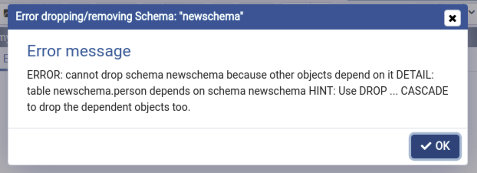

The following statements drop the schema. CREATE SCHEMA Sprockets AUTHORIZATION KrishnaĬREATE TABLE NineProngs (source INT, cost INT, partnumber INT) The statement creates the schema Sprockets that is owned by Krishna and a table Sprockets.NineProngs, and then grants SELECT permission to Anibal and denies SELECT permission to Hung-Fu. The following example starts with a single CREATE SCHEMA statement. Requires CONTROL permission on the schema or ALTER ANY SCHEMA permission on the database. For more information about catalog views, see Catalog Views (Transact-SQL). The new catalog views take into account the separation of principals and schemas that was introduced in SQL Server 2005. In such databases you must instead use the new catalog views. Old catalog views, including sysobjects, should not be used in a database in which any of the following DDL statements have ever been used: CREATE SCHEMA, ALTER SCHEMA, DROP SCHEMA, CREATE USER, ALTER USER, DROP USER, CREATE ROLE, ALTER ROLE, DROP ROLE, CREATE APPROLE, ALTER APPROLE, DROP APPROLE, ALTER AUTHORIZATION. Thus, it might be more convenient to use the program dropdb instead, which is a wrapper around this command.
#Drop cascade all schemas in pgadmin 4 code
As a result, code that assumes that schemas are equivalent to database users may no longer return correct results. We cannot drop a database that has any open connections, including our own connection from psql or pgAdmin III.We must switch to another database or template1 if we want to delete the database we are currently connected to. Information about schemas is visible in the sys.schemas catalog view.Ĭaution Beginning with SQL Server 2005, the behavior of schemas changed. If the schema contains objects, the DROP statement fails. The schema that is being dropped must not contain any objects. Is the name by which the schema is known within the database. ArgumentsĪpplies to: SQL Server ( SQL Server 2016 (13.x) through current version).Ĭonditionally drops the schema only if it already exists. To drop a column of a table, you use the DROP COLUMN clause in the ALTER TABLE statement as follows: ALTER TABLE tablename DROP COLUMN columnname Code language: SQL (Structured Query Language) (sql) When you remove a column from a table, PostgreSQL will automatically remove all of the indexes and constraints that involved the dropped column. To drop a schema if its empty (all objects in it have been dropped), use: DROP SCHEMA myschema To drop a schema including all contained objects, use: DROP SCHEMA myschema CASCADE See Section 5.14 for a description of the general mechanism behind this. To view Transact-SQL syntax for SQL Server 2014 and earlier, see Previous versions documentation.


 0 kommentar(er)
0 kommentar(er)
